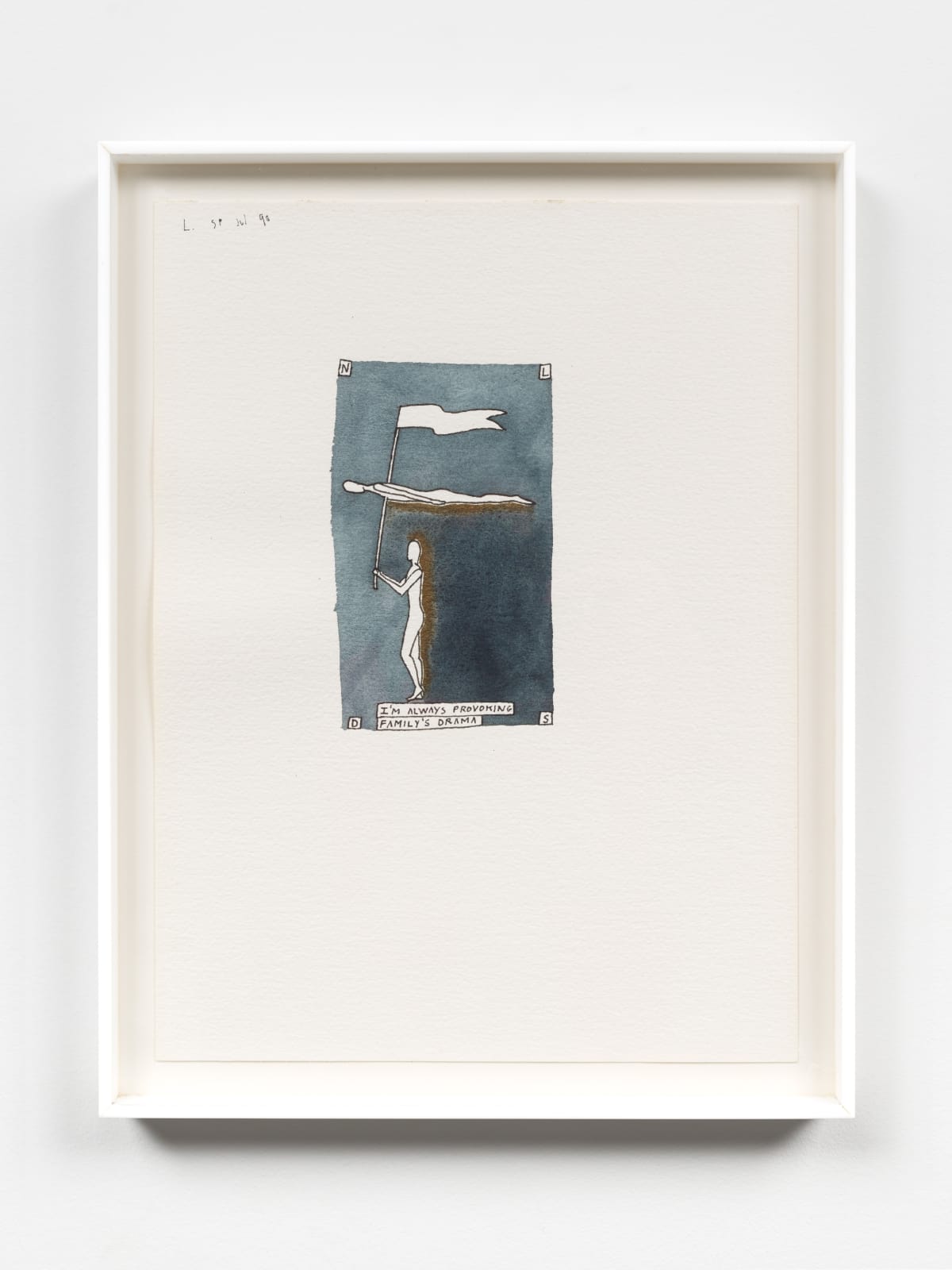José Leonilson
I’m always provoking family’s drama, 1990
permanent marker, metallic ink and watercolour on paper
30 x 22 cm
11 3/4 x 8 5/8 in
11 3/4 x 8 5/8 in
Leonilson's self-exposure is a romantic act of evoking the human and offering himself to the world — intimate, infallible, moving, poetic, simple and sincere. The works functioned, in his words,...
Leonilson's self-exposure is a romantic act of evoking the human and offering himself to the world — intimate, infallible, moving, poetic, simple and sincere.
The works functioned, in his words, like notebooks or diaries. Diaries of an intimacy revealed by making no distinction between what would be public or private in his work. He exposed everything — what he didn't like, he destroyed. What is left, therefore, is to be shown.
These concerns, doubts and questions seen in his work are overwhelming. He wanted to be just a drifter so he wouldn't be that "good guy in a bad package", who would be "always provoking family drama" by not fitting into society's standards. It reminds us that nothing is more melancholy than a hot Sunday afternoon in any country town where the sepulchral silence is broken by the bells of a church announcing the end of the day.
"A sense of vulnerability permeates the last stage of Leonilson's work. AIDS changed the course of his life and marked his artistic production, giving it a final and irreducible terminology. The simplicity and unpretentiousness characteristic of his work, particularly his drawing, are strained by the contents they make explicit: an announced death, as it is in cases of irreversible illnesses, and an intense search for meaning for the crossing of life. Constrained by the possibilities of sexual fulfillment, AIDS brought him not to the margins but to the center of the question. The energy of desire finds its loving realization, now consciously, in sublimation, which forges the interstices of language. His work, for the most part, has always been involved with the meaning of being, with his identity and with the full exercise of life as the only values to be sought after. In this final stage of his career, however, his interest focuses on the issue of the body, his own body made into a metaphor, seeking, through art, some possibility of transcendence. Leonilson becomes the observer of his own process, revealing himself publicly: the body is assumed in its condition of a desiring machine, which contains mind and spirit and is in permanent conflict with the world"
The works functioned, in his words, like notebooks or diaries. Diaries of an intimacy revealed by making no distinction between what would be public or private in his work. He exposed everything — what he didn't like, he destroyed. What is left, therefore, is to be shown.
These concerns, doubts and questions seen in his work are overwhelming. He wanted to be just a drifter so he wouldn't be that "good guy in a bad package", who would be "always provoking family drama" by not fitting into society's standards. It reminds us that nothing is more melancholy than a hot Sunday afternoon in any country town where the sepulchral silence is broken by the bells of a church announcing the end of the day.
"A sense of vulnerability permeates the last stage of Leonilson's work. AIDS changed the course of his life and marked his artistic production, giving it a final and irreducible terminology. The simplicity and unpretentiousness characteristic of his work, particularly his drawing, are strained by the contents they make explicit: an announced death, as it is in cases of irreversible illnesses, and an intense search for meaning for the crossing of life. Constrained by the possibilities of sexual fulfillment, AIDS brought him not to the margins but to the center of the question. The energy of desire finds its loving realization, now consciously, in sublimation, which forges the interstices of language. His work, for the most part, has always been involved with the meaning of being, with his identity and with the full exercise of life as the only values to be sought after. In this final stage of his career, however, his interest focuses on the issue of the body, his own body made into a metaphor, seeking, through art, some possibility of transcendence. Leonilson becomes the observer of his own process, revealing himself publicly: the body is assumed in its condition of a desiring machine, which contains mind and spirit and is in permanent conflict with the world"
